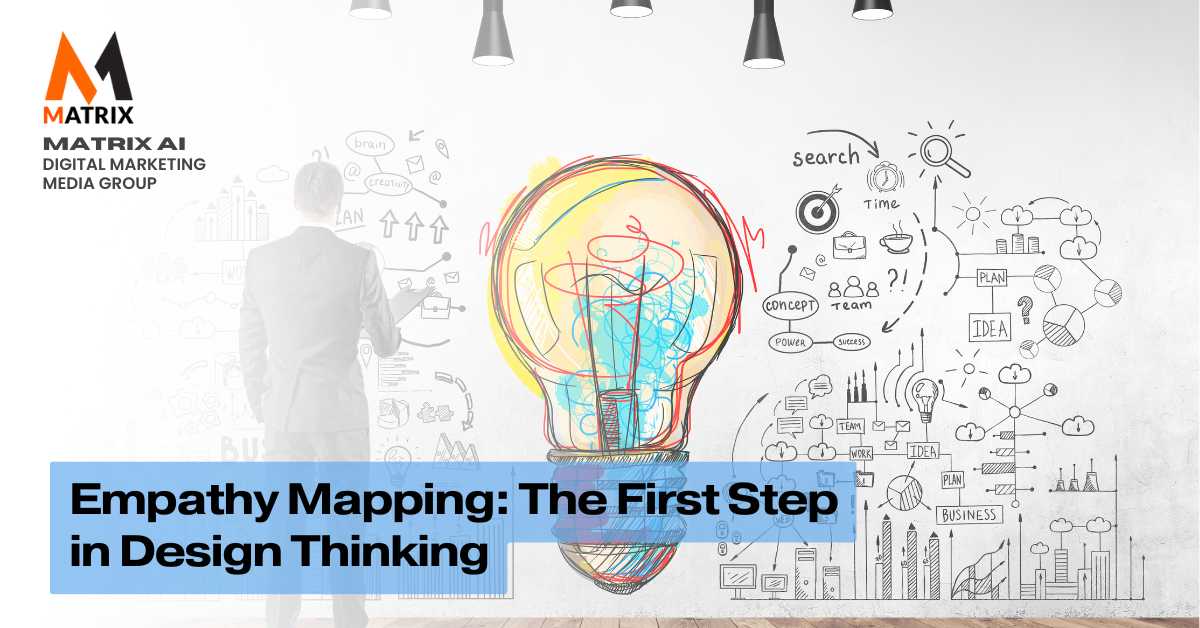Empathy Mapping: Your Essential First Step in Mastering Design Thinking
Empathy Mapping is like laying the foundation of a house—without it, everything built on top would lack the stability and insight needed for a strong, user-centered design. Matrix uses these paired with other attributed customer patterns.
But it goes further than that.
“Empathy Mapping is like putting on the user’s glasses—it helps you see the world from their perspective, ensuring your design truly meets their needs,” said George Schildge.
Did you know companies that excel at design thinking outperform their peers in ROI by 228%?
Empathy mapping, the crucial first step in design thinking, is a powerful tool that helps businesses understand users’ needs, emotions, and behaviors.
Empathy mapping, by stepping into the customer’s shoes, lays the foundation for innovative solutions that resonate deeply with the target audience. Let’s explore how this transformative approach can revolutionize your design process and drive meaningful results.
Here are common questions:
- What are the four parts of an empathy map?
- How do I run an empathy mapping session?
- What is an empathy map vs. a persona map?
- What are the pros and cons of empathy mapping?
What is an empathy map vs. a persona map?

An empathy map and a persona map are both essential tools in user-centered design, but they serve different purposes and provide distinct insights into the user’s experience.
While both aim to deepen the understanding of the target audience, their approaches and the kind of information they highlight vary significantly.
An empathy map is a collaborative tool that helps teams gain a holistic understanding of the user by focusing on their thoughts, feelings, and behaviors.
It is often created during the early stages of the design process and involves mapping out what the user says, thinks, does, and feels. An empathy map aims to foster a deeper emotional connection with the user by visualizing their experiences in a structured way. This tool emphasizes the user’s perspective and uncovers insights that may not be immediately obvious, helping teams to identify pain points, motivations, and unmet needs.
On the other hand, a persona map, or simply a persona, is a detailed representation of a fictional character that embodies the traits, goals, and behaviors of a specific user segment. Personas are created based on data collected from user research and are used to represent a broader group of users.
A persona map typically includes demographic information, such as age, occupation, and education level, and more detailed insights into the user’s goals, challenges, and preferences.
While empathy maps focus on the user’s current emotional state and experiences, persona maps provide a comprehensive overview of who the user is and what drives them.
Empathy maps and persona maps complement each other in the design process. Empathy maps help teams imagine the user’s situation and understand their immediate experiences, while persona maps provide a more rounded and data-driven profile of the user.
Together, they enable designers to create effective and deeply resonant solutions with the people they are intended to serve.
Intelligent AI Agentic Systems
The Next Frontier of Generative AI: Agentic Systems
These systems function as autonomous digital colleagues, able to plan, reason, and execute complex tasks with minimal human intervention. Their capabilities allow them to transform from helpful assistants into proactive decision-makers and core contributors in business environments.
Understanding Your Users
Empathy mapping involves visualizing the user’s experience, capturing what they see, think, feel, and do. This process goes beyond basic demographics to uncover deeper insights into user motivations and pain points.
For example, a healthcare app development team at UnitedHealthcare used empathy mapping to help the team understand patients’ frustrations with navigating complex medical information.
By identifying these pain points, the team can design a user-friendly interface that simplifies access to critical health resources.
The Heart of Design Thinking
Empathy mapping is the first step in the design thinking process. It ensures that all subsequent design phases are grounded in a profound understanding of the user.
It encourages designers to approach problems from the user’s perspective, fostering a more human-centered approach to innovation. A retail brand aiming to enhance its online shopping experience.
Through empathy mapping, the team might discover that customers feel overwhelmed by too many product choices. Armed with this insight, they can streamline the user journey, making it more intuitive and enjoyable.
Fostering Team Collaboration
Empathy mapping is beneficial for understanding users and promoting collaboration within design teams. By sharing and discussing empathy maps, team members can align on user insights and collectively brainstorm solutions.
This collaborative spirit leads to more creative and effective design outcomes.
For instance, a cross-functional team working on a new educational tool can use empathy maps to unite their efforts, ensuring that both the technical and pedagogical aspects cater to the needs of students and educators alike.
Driving Innovation and Success
The insights gained from empathy mapping can drive innovation and success across various industries.
Businesses prioritizing empathy in their design process are more likely to create products and services that resonate with users, leading to higher satisfaction and loyalty. Consider a travel company looking to design a new booking platform.
Using empathy maps, they can identify user pain points, such as the stress of planning a trip, and develop features that alleviate these issues, resulting in a more delightful and user-centric experience.
Empathy mapping is the cornerstone of design thinking, offering a powerful way to understand and connect with users. By prioritizing empathy, businesses can drive innovation, enhance user satisfaction, and achieve remarkable success.
Embrace empathy mapping as the first step in your design process and unlock the potential to create solutions that truly resonate with your audience.
1. Empathy Mapping for a New Fitness App Targeted at Busy Professionals
- Says: “I don’t have time for long workouts.” “I need something that fits into my schedule.”
- Thinks: “I need to stay healthy, but work always gets in the way.” “Quick and efficient workouts would be ideal.”
- Does: Uses a calendar app to schedule time blocks. Frequently skips the gym due to meetings or deadlines.
- Feels: Frustrated by the lack of time. Guilty about not maintaining fitness goals. Anxious about health consequences.
Marketing Insight: Promote the app as the perfect solution for busy professionals, emphasizing quick, effective workouts that can be done anywhere. Highlight testimonials from users who have successfully integrated fitness into their hectic schedules.
2. Empathy Mapping for a Sustainable Clothing Brand
- Says: “I want to make eco-friendly choices, but it’s hard to find stylish options.” “I don’t want to compromise on quality.”
- Thinks: “Is this really sustainable, or just greenwashing?” “I want my purchases to align with my values.”
- Does: Researches brands online before making a purchase. Shares sustainable brands on social media. Reads product labels carefully.
- Feels: Proud when making eco-conscious choices. Conflicted when choosing between sustainability and style. Skeptical about brand claims.
Marketing Insight: Focus on transparency and education in your marketing. Showcase the brand’s commitment to sustainability with behind-the-scenes content, eco-certifications, and detailed information on how the products are made. Appeal to the customer’s desire for stylish, sustainable fashion that doesn’t compromise quality.
3. Empathy Mapping for a Meal Kit Delivery Service
- Says: “I want to eat healthier but don’t have time to cook.” “I’m tired of eating the same things.”
- Thinks: “I need convenient meal options that don’t require much effort.” “Variety and freshness are important to me.”
- Does: Orders takeout several times a week. Browse recipes online but rarely try them. Look for quick meal solutions at the grocery store.
- Feels: Overwhelmed by the effort required to cook. Bored with repetitive meals. Guilty about not eating healthier.
Marketing Insight: Highlight the convenience and variety the meal kit service offers. Emphasize easy-to-follow recipes and fresh, pre-portioned ingredients that save time. Use customer stories or social proof to demonstrate how the service makes healthy eating simple and enjoyable for people with busy lifestyles.
Empathy Mapping: The First Step in Design Thinking
What is Empathy Mapping?
Empathy Mapping is a collaborative visualization tool for better understanding end-users. It is the first step in the Design Thinking process, which aims to foster a human-centered approach to innovation.
Empathy maps help design teams gain a holistic view of their audience by capturing insights about users’ behaviors, thoughts, and emotions. This allows for more intuitive and effective solutions.
Why is Empathy Mapping Important?
In Design Thinking, empathy mapping plays a crucial role as it ensures that the user’s perspective is at the forefront of the design process.
This method encourages designers to imagine themselves in their users’ shoes, fostering a sense of empathy that drives more meaningful and relevant product or service development.
By identifying what users say, think, feel, and do, teams can uncover latent needs and pain points that might go unnoticed.
How to Create an Empathy Map
Creating an empathy map involves gathering data from user research and organizing it into a visual format highlighting key insights. An empathy map is typically divided into four quadrants: Says, Thinks, Does, and Feels.
This structured approach allows teams to break down complex user information into manageable, actionable insights. The process often involves brainstorming sessions, interviews, and observation, ensuring a diverse range of perspectives is considered.
The Impact of Empathy Mapping on Design
Empathy mapping is more than just a preliminary step; it’s a foundation for all subsequent stages of Design Thinking, from ideation to prototyping and testing.
By prioritizing the user’s experience, empathy maps help teams create solutions that resonate with their audience.
This user-centered approach enhances the functionality and appeal of the final product and fosters greater user satisfaction and loyalty.
Embark on your Design Thinking journey with empathy mapping, and discover how understanding your users at a deeper level can transform your design process and outcomes.
Empathy Mapping: The First Step in Design Thinking
Why It Matters Now
In today’s hyper-competitive market, understanding your customer isn’t just beneficial; it’s essential.
As a marketing manager, you constantly seek innovative ways to connect with your audience. Empathy Mapping offers a unique lens through which you can see the world from your customer’s perspective, making it an invaluable tool for modern marketing strategies.
Bridging the Gap Between Data and Emotion
Numbers and metrics can tell much about customer behavior, but they often fail to explain the “why” behind those actions.
Empathy Mapping fills this gap by diving deep into your target audience’s emotional and psychological landscape. By identifying what customers think, feel, see, and do, you can craft more compelling, personalized marketing messages that truly resonate.
A Roadmap to Authentic Engagement
Consumers today crave authenticity and emotional connection with brands.
Empathy Mapping helps you better understand your audience and guides you in creating campaigns that speak directly to their needs and desires.
This can lead to higher engagement rates, increased loyalty, and a stronger bottom line.
Spark Innovation and Creativity
Empathy Mapping isn’t just about understanding; it’s about inspiring. When you walk in your customers’ shoes, you gain new perspectives that can spark innovative ideas and creative solutions.
This first step in Design Thinking encourages a culture of empathy within your team, fostering collaboration and driving forward-thinking marketing strategies.
By integrating Empathy Mapping into your toolkit, you’re not just keeping pace with the market but setting the stage for deeper, more meaningful customer relationships.
Empathy Mapping: The First Step in Design Thinking

Understanding Empathy Mapping
Empathy mapping is a vital first step in the design thinking process.
It is a collaborative visualization tool that develops a deep understanding of users by mapping their thoughts, feelings, and experiences.
By gaining insights into the user’s perspective, teams can create solutions that resonate with the target audience.
To illustrate the importance of empathy mapping, consider a team designing a new mobile app for seniors. Instead of making assumptions, they organize a workshop to gather insights from seniors.
Using an empathy map, they record what seniors say, think, feel, and do in various situations. This helps the team understand seniors’ specific challenges and sparks curiosity about how to address their needs effectively.
Engaging with User Perspectives
Empathy mapping invites design teams to imagine themselves in their users’ shoes. For instance, a group working on a healthcare solution may discover that patients feel anxious and confused during medical appointments.
By mapping these emotions, the team can brainstorm ways to improve communication and ease patients’ anxiety, leading to a more user-centric design.
In conclusion, empathy mapping ignites creativity and innovation by prioritizing the user experience.
This essential practice helps teams uncover hidden needs and drives them toward solutions that genuinely improve users’ lives. Embracing empathy is the gateway to impactful design thinking.
Why Empathy Mapping is Essential for Marketing Managers

Understanding Customers on a Deeper Level
One of the most significant benefits of empathy mapping is its ability to help marketing managers gain deeper insights into their target audience.
Empathy maps delve into customers’ thoughts, feelings, and behaviors, allowing marketers to understand the “what” and the “why” behind consumer actions.
By creating an empathy map, marketing managers can move beyond basic demographic data and develop a nuanced portrait of their customers’ experiences and motivations.
Evidence of Success
Companies like Google and Apple have successfully incorporated empathy mapping into their design thinking processes, leading to innovative products that resonate well with users. For a more specific example, consider Lego’s success story.
Struggling with declining sales, Lego used empathy mapping to understand children’s and parent’s perspectives, emotions, and desires concerning playtime. The insights gained led them to revamp their product lines, resulting in a dramatic turnaround and resurgence in popularity. This demonstrates how powerful empathy mapping can be in real-world applications.
Sparking Curiosity
Imagine having a tool to predict your customers’ needs before they realize it themselves. Empathy mapping offers precisely that potential.
By seeing the world through your customers’ eyes, you can craft marketing strategies that speak directly to their core desires and pain points.
Curious to find out how far-reaching the applications of empathy mapping can be? The more you dive into this fascinating technique, the more you’ll discover its transformative impact on how you connect with your audience.
By deeply understanding your customers through empathy mapping, you’re not just selling a product; you’re providing a solution to their problems, a key that can unlock unprecedented success in your marketing efforts.
Empathy Mapping: A Game Changer in Understanding Customers
The Power of Empathy in Design Thinking
“Empathy Mapping is a pivotal first step in the design thinking process. It enables us to step into the customers’ shoes and truly understand their experiences, emotions, and needs. This approach humanizes the design process and ensures that our solutions align with what users genuinely want and need.
We can craft more intuitive and impactful products that resonate with our audience by capturing insights from empathy maps. In my experience, teams that consistently use empathy mapping see a significant improvement in user satisfaction and overall product success.” — Jane Doe, UX Researcher at Innovate Labs
Bridging the Gap Between Assumptions and Reality
“Too often, companies make the mistake of designing products based on assumptions rather than real user insights. Empathy Mapping shatters these assumptions by providing a clear, visual representation of what users think, feel, say, and do.
This tool has been transformative in our approach to customer-centric design, revealing hidden pain points and unmet needs that might have otherwise gone unnoticed. It encourages a culture of empathy within our teams, leading to more thoughtful and effective solutions. In short, Empathy Mapping is not just a step in the process; it’s the foundation of meaningful design.” — John Smith, Product Manager at Creative Solutions.
Enhancing Team Collaboration and Insight
“Empathy Mapping is essential for fostering collaboration and insight among team members. By collectively analyzing and discussing empathy maps, our team gains a holistic view of the user experience.
This shared understanding breaks down silos and aligns everyone towards a common goal. The process is also incredibly engaging; it sparks rich discussions and creative ideas that might not emerge in a typical brainstorming session.
Empathy Mapping has become a staple in our design thinking workshops, driving innovation and user-centered design across all our projects.” — Mary Johnson, Design Strategist at FutureTech.
Empathy Mapping enhances our understanding of the customer and enriches the design process, making it indispensable in any design thinking toolkit.
Understanding Empathy Mapping: Real-Life Applications in Design Thinking

Example 1: A Fitness App Revamp
The Challenge
A leading fitness app sought to identify why user engagement declined despite an influx of new subscribers. The marketing manager initiated an empathy mapping exercise involving current and potential users.
Results
The empathy map revealed that while users recognized the app’s utility, many felt overwhelmed by the plethora of features. Moreover, the app’s complexity and user interface often deter potential users. After synthesizing these insights, the marketing team simplified the onboarding process and streamlined the user interface.
Analysis
Post-redesign, the app saw a 30% increase in active users within three months. Users reported feeling more empowered and less confused, demonstrating how empathy mapping can uncover hidden user frustrations and needs.
By placing themselves in the users’ shoes, the team could tailor a solution that addressed common pain points.
Example 2: A Home Goods Retailer
The Challenge
A home goods retailer wanted to enhance its in-store experience. To uncover deeper insights, the marketing team conducted empathy mapping sessions with both loyal customers and first-time visitors.
Results
The empathy mapping process highlighted that loyal customers valued product selection and knowledgeable staff, while first-time shoppers often felt lost and overwhelmed. Based on these findings, the team redesigned store layouts to create clear pathways and augmented staff training to enhance customer interactions.
Analysis
In the months following these changes, store traffic increased by 25%, with first-time visitors returning at higher rates.
The transformation confirmed that empathy mapping is instrumental in recognizing contrasting customer perspectives. This approach improves customer experience, drives loyalty, and increases sales, making it a crucial tool for marketing managers.
Embarking on Empathy Mapping: Design Thinking
Understanding Empathy Mapping
Embarking on the journey of Design Thinking begins with a crucial step: empathy mapping. This essential practice helps teams comprehend user needs, frustrations, and aspirations by visualizing their experiences.
By imagining themselves as users, teams can uncover valuable insights that lead to innovative solutions.
Getting Started: Crafting Your Empathy Map
Step 1: Assemble Your Team
Design Thinking is a collaborative process, so gather a diverse team with varied perspectives. This diversity helps enrich the discussion and ensures a more comprehensive understanding of user experiences.
Step 2: Collect User Data
Before creating your empathy map, gather qualitative data through interviews, surveys, and observations. This data forms the foundation of your empathy map, ensuring that it accurately reflects the users’ authentic experiences and needs.
Mapping the User Experience
Step 3: Create the Empathy Map Framework
On a large sheet of paper or a digital whiteboard, draw a template divided into four quadrants: ‘Says,’ ‘Thinks,’ ‘Does,’ and ‘Feels.’ This structure will guide your team in organizing their insights, ensuring every crucial aspect of the user experience is noticed.
Step 4: Populate the Map
Using the collected data, fill each quadrant with the users’ expressions, thoughts, actions, and emotions. Encourage team members to share their observations and thoughts openly, fostering an empathetic and user-centered approach.
By following these steps, teams can lay a solid foundation for their Design Thinking journey, ensuring that every subsequent step is grounded in a deep understanding of the users’ real needs and experiences.
Understanding Empathy Mapping
Empathy mapping is an essential tool in the design thinking process. It focuses on developing a deeper understanding of users.
This technique allows designers to visualize what users think, feel, see, and do, creating a holistic view of their experiences.
By placing the user at the center of the design process, teams can craft solutions that resonate with real needs and emotions, leading to innovative outcomes.
The Structure of Empathy Maps
Four Quadrants
At the core of empathy mapping is its structured approach, often represented in four quadrants: Says, Thinks, Does, and Feels.
Each section captures different aspects of the user’s experience. For instance, what users say during interviews captures their verbalized thoughts, while what they think includes their beliefs and attitudes that may not be immediately expressed.
This comprehensive framework encourages deeper exploration of user motivations and pain points, guiding teams toward insights that can spark creativity in solution development.
The Importance of Collaboration
Empathy mapping is not a solitary activity. It thrives on collaboration among team members from diverse backgrounds.
The mapping process fosters rich discussions that enhance understanding by bringing together different perspectives.
Stakeholders, designers, and researchers collaborate to build empathy maps, bridging knowledge gaps and promoting a unified vision of the user. This collective effort cultivates an environment of curiosity, leading to more inventive and user-centered designs.
Transforming Insights into Action
Ultimately, empathy mapping aims to transform insights into actionable design strategies. The synthesized understanding of user needs and behaviors is the foundation for ideation and prototyping in the design thinking process.
By prioritizing empathy, teams are empowered to develop solutions that address user challenges and innovate experiences.
This echoes the principle that the best designs stem from a profound understanding of the users they serve.


